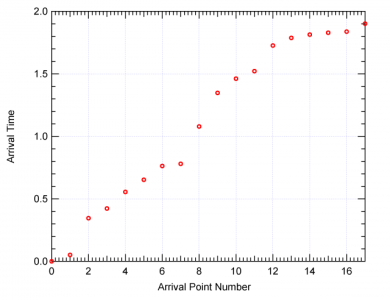
Poisson Arrival Times
Function/WAVE fPoissonArrival(interval, lambda) // cumulative Poisson Arrival times in "wArrTime" variable interval, lambda // interval = counting interval; lambda = arrival rate/unit time make/O/N=1 wArrTime // this will contain the cumulative arrival times wArrTime[0] = 0 variable i = 0 Do i+=1 InsertPoints i+1, 1, wArrTime wArrTime[i] = wArrTime[i-1] + expnoise(1/lambda) // independent arrival increments are exponentially distributed While( wArrTime[i] < interval ) // stop after interval exceeded DeletePoints i, 1, wArrTime // delete last point, which is outside interval wave wout = wArrTime Return wout End
Attached is a graph of a typical output; Tests of repeated trials showed excellent agreement with the exact Poisson count distribution.
With recent improvements to Igor, this function returns a WAVE reference to the output. In your user function, it is used as:
WAVE wout = fPoissonArrival(interval, lambda)
I chose to use a simple, if inefficient, method for adding sequential arrival times. Using a pre-sized Igor wave might sometimes be quicker, but would ultimately require end-point checking, and either truncation or point addition since the 'a priori' number of arrivals is unknown.


Forum

Support

Gallery
Igor Pro 10
Learn More
Igor XOP Toolkit
Learn More
Igor NIDAQ Tools MX
Learn More

_____________________________
Omidiu part of Traduceri legalizate team
January 6, 2013 at 11:15 am - Permalink
You are welcome. The intent of the snippet is indeed to enable the creation of a Poisson noise waveform. Use the arrival times in the returned wave to create your own impulse functions at those times, or by convolution with those impulses, any other pulse waveform of your choice. An "impulse" here means a single 'y' value in a wave at your closest scaled x-value (time) or vs the x-wave of arrival times.
January 6, 2013 at 02:47 pm - Permalink